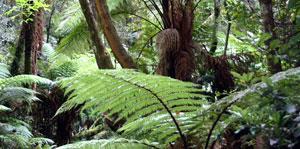Original estimates of gas output almost halved
The startling news that trees and other plants can give off large quantities of methane - a potent greenhouse gas - took biologists and atmospheric chemists by surprise in January this year.
But since then, scientists have criticised the way that the results, obtained from small laboratory-based experiments, were scaled up to produce an estimate of global methane emissions from plants.
So scientists involved with the original research have now fine-tuned their calculations and set an upper limit on plants’ total methane emissions that almost halves their original suggestion.1

Frank Keppler at the Max Plank institute for nuclear physics, Heidelberg, Germany, led the research team that first detected the plant’s methane.2 But critics say that although the observations of methane emissions were sound, there was no justification for Keppler’s assumption that all plant matter behaves in the same way.
Miko Kirschbaum of the Cooperative research centre for greenhouse accounting, Canberra, Australia, points out that it is important to differentiate between plant materials that are in light or dark places, such as the wood in trees or roots.
Kirschbaum argues that Keppler’s calculations, based on methane emission per unit of metabolically active mass of plant, produced a gross overestimate of global emissions. In contrast, Kirschbaum has published3 calculations that ignored material not exposed to light, although he concedes that this condition is likely to lead to underestimates.
’At this stage, any extrapolation to the global scale is highly speculative,’ said Sander Houweling at the Netherlands Institute for Space Research, Utrecht, who worked with Keppler on the latest effort to estimate plants’ methane emissions.
Balancing the budget
Houweling used satellite measurements of methane to recalculate plants’ emissions, and work out how that fits into the global methane budget of 400 to 640 million tonnes of emissions per year.
Based on this data, Houweling has suggested that plants emit no more than 125 million tonnes of methane per year, compared to Keppler’s original upper limit of 236 million tonnes per year. Houweling added that even 125 million tonnes is very high: ’85 would be a more realistic upper limit.’
He stressed that Keppler’s observation that plants in the lab were emitting methane was ’robust’, and Kirschbaum agrees that the initial observation was significant. ’It adds to our understanding of the type of processes that can release methane,’ he said. ’That this process has not previously been observed is really remarkable - it’s a poignant reminder just how much there is in the world that we still don’t understand adequately.’
Houweling believes that further research should narrow the uncertainties surrounding the methane budget. And although Keppler’s research prompted some people to claim that planting tress was no longer a useful way to mitigate climate change, Kirschbaum insists this is wrong. ’The benefit of tree planting is about 100 times as great as any disadvantage that comes from methane emissions,’ he said.
Katharine Sanderson
References
et alGeophysical Research Letters33et alNature439et alFunctional Plant Biology33, 521






No comments yet